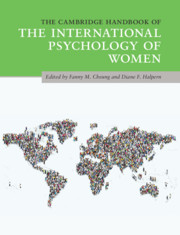Book contents
- The Cambridge Handbook of the International Psychology of Women
- The Cambridge Handbook of the International Psychology of Women
- Copyright page
- Dedication
- Contents
- Figures
- Tables
- Contributors
- Acknowledgments
- Section 1 The Underpinnings of Sex and Gender and How to Study Them
- Section 2 Developmental Perspectives of the International Psychology of Women
- Section 3 Cognitive and Social Factors
- Section 4 Work and Family Issues
- Section 5 Inequality and Social Justice
- 26 Girls, Boys, and Schools
- 27 Understanding Gender Inequality in Poverty and Social Exclusion through a Psychological Lens
- 28 Understanding Women’s Antisocial and Criminal Behavior
- 29 Sexual Assault
- 30 Intercultural Relationships, Migrant Women, and Intersection of Identities
- Section 6 Health and Well-Being
- Epilogue Some Final Thoughts and Take-Home Messages
- Index
- References
30 - Intercultural Relationships, Migrant Women, and Intersection of Identities
from Section 5 - Inequality and Social Justice
Published online by Cambridge University Press: 20 July 2020
- The Cambridge Handbook of the International Psychology of Women
- The Cambridge Handbook of the International Psychology of Women
- Copyright page
- Dedication
- Contents
- Figures
- Tables
- Contributors
- Acknowledgments
- Section 1 The Underpinnings of Sex and Gender and How to Study Them
- Section 2 Developmental Perspectives of the International Psychology of Women
- Section 3 Cognitive and Social Factors
- Section 4 Work and Family Issues
- Section 5 Inequality and Social Justice
- 26 Girls, Boys, and Schools
- 27 Understanding Gender Inequality in Poverty and Social Exclusion through a Psychological Lens
- 28 Understanding Women’s Antisocial and Criminal Behavior
- 29 Sexual Assault
- 30 Intercultural Relationships, Migrant Women, and Intersection of Identities
- Section 6 Health and Well-Being
- Epilogue Some Final Thoughts and Take-Home Messages
- Index
- References
Summary
This chapter examines research that illuminates the experiences of international immigrants, especially women. Our emphasis is on the women’s multiple social identities and their intersectionality, which uniquely shape their experiences in the settlement society depending on the broader historical and intercultural contexts of the countries between which they travel. Starting with a brief discussion of selected social psychological frameworks relevant to immigrants, including social identity theory and intersectionality theory, the chapter reviews research on immigrant women’s experiences in several topical areas, examining the impacts of religion, sexuality, domestic violence, media stereotypes, and career opportunities in the global labor market. Immigrant women’s experiences today are highly heterogeneous. The chapter ends with a call for an in-depth examination of intersectionality of identities from an intercultural perspective.
- Type
- Chapter
- Information
- The Cambridge Handbook of the International Psychology of Women , pp. 434 - 448Publisher: Cambridge University PressPrint publication year: 2020
References
Suggested Readings

Emi Kashima was born and educated in Japan. Through her experiences as an AFS exchange student when she went to Minnesota to become a farmer’s daughter in 1975 as one of 100 Japanese students who spent a year in the United States, Kashima became interested in intercultural adaptation and cross-cultural psychology. In 1989, she obtained her PhD from the University of Illinois, Urbana-Champaign. She is currently Professor at La Trobe University in Australia, where her family has lived for over 30 years. Her research topics include acculturation, language use, stereotype communication, and psychological threats. Her projects have been funded by the Australia Research Council.

Saba Safdar is a Persian Canadian Professor in the Psychology Department at the University of Guelph in Canada. Born in Tehran, Safdar grew up in different cities across Iran until she finished high school. The Islamic Revolution of Iran and the aftermath of political instability in the country, including the war between Iran and Iraq, was the major reason for her family to move to Canada. Safdar received her PhD in 2002 from York University, Toronto, and has held an academic position at the University of Guelph since 2002. She is Director of the Centre for Cross-Cultural Research at the University of Guelph. Her research focus is on acculturation and examining factors that are relevant to understanding the adaptation processes of newcomers, including immigrants, refugees, and international students. Her research has been funded by the Social Sciences and Humanities Research Council of Canada, the Canada Foundation for Innovation, and Erasmus Mundus Scholarship, among others. In addition to her Canadian academic position, Safdar has spent periods of six months to two years working and living in the USA, the UK, France, and Spain. She has held academic appointments in the USA, the UK, France, Spain, India, Kazakhstan, and Russia.

